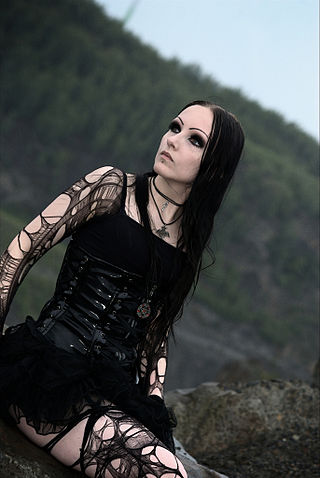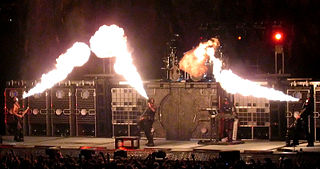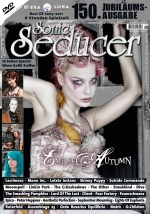
Goth is a music-based subculture that began in the United Kingdom during the early 1980s. It was developed by fans of gothic rock, an offshoot of the post-punk music genre. Post-punk artists who presaged the gothic rock genre and helped develop and shape the subculture include Siouxsie and the Banshees, Bauhaus, the Cure, and Joy Division.
Gothic rock is a style of rock music that emerged from post-punk in the United Kingdom in the late 1970s. The first post-punk bands which shifted toward dark music with gothic overtones include Siouxsie and the Banshees, Joy Division, Bauhaus, and the Cure.
Deathrock is a rock music subgenre incorporating horror elements and gothic theatrics. It emerged from punk rock on the West Coast of the United States in the early 1980s and overlaps with the gothic rock and horror punk genres. Notable deathrock acts include Christian Death, Kommunity FK, 45 Grave, and Super Heroines.

Gothic fashion is a clothing style worn by members of the goth subculture. A dark, sometimes morbid, fashion and style of dress, typical gothic fashion includes black dyed hair and black clothes. Both male and female goths can wear dark eyeliner, dark nail polish and lipstick, and dramatic makeup. Styles are often borrowed from the Elizabethans and Victorians. BDSM imagery and paraphernalia are also common. Gothic fashion is sometimes confused with heavy metal fashion and emo fashion.
Alternative metal is a genre of heavy metal music that combines heavy metal with influences from alternative rock and other genres not normally associated with metal. Alternative metal bands are often characterized by heavily downtuned, mid-paced guitar riffs, a mixture of accessible melodic vocals and harsh vocals and sometimes sounds that are unconventional within other heavy metal styles. The term has been in use since the 1980s, although it came into prominence in the 1990s.
Dark wave is a music genre that emerged from the new wave and post-punk movement of the late 1970s. Dark wave compositions are largely based on minor key tonality and introspective lyrics and have been perceived as being dark, romantic and bleak, with an undertone of sorrow. The genre embraces a range of styles including cold wave, ethereal wave, gothic rock, neoclassical dark wave and neofolk.
A number of heavy metal genres have developed since the emergence of heavy metal during the late 1960s and early 1970s. At times, heavy metal genres may overlap or are difficult to distinguish, but they can be identified by a number of traits. They may differ in terms of instrumentation, tempo, song structure, vocal style, lyrics, guitar playing style, drumming style, and so on.

Paradise Lost are an English gothic metal band. Formed in Halifax, West Yorkshire in 1988, they are considered to be among the pioneers of the death-doom genre and regarded as the main influence for the later gothic metal movement. Bands that have cited Paradise Lost as an influence, or have covered them, include My Dying Bride, Anathema, The Gathering, Amorphis, Cradle of Filth, Katatonia, Moonspell, Lacuna Coil, HIM, Nightwish and many others. As of 2005, Paradise Lost have sold over two million albums worldwide.
Rock music has been performed and heard in Lithuania since the mid-1960s. At first, repression by the Soviet authorities meant that rock was performed only at illegal gatherings, while music from the West was available on Radio Luxembourg or smuggled records. As pressure eased somewhat, rock musicals began to be released, such as Velnio nuotaka and Ugnies medžioklė su varovais.
Pagan rock is a genre of rock music created by adherents of neopagan traditions. It emerged as a distinct genre from gothic rock in the 1980s. Bands in this genre will often use pagan and occult imagery and deal with pagan themes. In some cases the definition is stretched to include rock bands embraced by modern Pagans.
Dark cabaret is a musical genre that draws on the aesthetics of burlesque, vaudeville and Weimar-era cabaret, with live performances that borrow from the stylings of goth and punk.
Gothic metal is a fusion genre combining the aggression of heavy metal with the dark atmospheres of gothic rock. The music of gothic metal is diverse with bands known to adopt the gothic approach to different styles of heavy metal music. The genre originated during the early 1990s in the United Kingdom originally as an outgrowth of death-doom, a fusion of death metal and doom metal. Lyrics are generally dark and introspective with inspiration from gothic fiction as well as personal experiences.

Dark culture, also called dark alternative scene, is a mixture of thematically related subcultures including the goth and dark wave subculture, the dark neoclassical/dark ambient scene, parts of the post-industrial scene parts of neofolk and the early gothic metal scene. Dark culture's origin lies in followers of dark wave and independent music, but over the decades it has developed to a social network held together by a common concept of aesthetics, self-representation, and individualism. The musical preferences of the dark scene are characterized by a mix of styles ranging from gothic metal, to industrial dance music and dark ambient, to dark neoclassical, neo-medieval and dark folk music, to gothic rock, dark wave and post-punk, the darker ends of electropop.
Ethereal wave, also called ethereal darkwave, ethereal goth or simply ethereal, is a subgenre of dark wave music that is variously described as "gothic", "romantic", and "otherworldly". Developed in the early 1980s in the UK as an outgrowth of gothic rock, ethereal wave was mainly represented by 4AD bands such as Cocteau Twins, This Mortal Coil, and early guitar-driven Dead Can Dance.

Neue Deutsche Härte, sometimes abbreviated as NDH, is a subgenre of rock music that developed in Germany and Austria during the early-to-mid 1990s and early 2000s. Alluding to the style of Neue Deutsche Welle, the term was coined by the music press after the 1995 release of the German rock and metal band Rammstein's first studio album Herzeleid.
Dead Artist Syndrome was a Christian gothic rock band formed in 1989 in Orange County, California. The group consisted of singer-songwriter Brian Healy and a rotating cast of side men. Healy was dubbed the "father of Christian goth" by Rozz Williams, and was an ordained minister. The name of D.A.S. according to Healy is "Dead Artist Syndrome means greater in death than in life, be it James Dean, Van Gogh or Jesus Christ". His debut album Prints of Darkness was a notable, groundbreaking release. The band had been sporadically active due to health issues, releasing two albums in the 2000s, and another in 2015. In 2006, Dead Artist Syndrome was named "Outstanding Orange County Band" by the editors and readers of Rock City News, a Los Angeles local music paper. For several years Healy was privately in poor health his gallbladder exploded while recording vocals resulting in emergency surgery, and a neurological disorder his wife Marie Tullai Healy described as "a combination of Michael J. Fox and the late Foster Brooks everybody thought he was drunk, Brian was falling down he broke his arm, slurring his speech trying to complete his record, next thing we know he's in a wheelchair, finally in 2012 they discovered the cause and he had brain surgery and is 100% back to his old self and had no idea any of this was going on, inside his head everything was fine". Healy said on his Facebook page 'He's back" and is actively recording, producing others and hosting Frontline Records Rewind Broadcast and podcast Healy died January 12, 2020, of a brain hemorrhage.
Kohllapse is a gothic-doom metal band from Canberra, Australia, formed in the early 1990s. They were well known in the Christian music scene because of the members' beliefs; however, the band developed notoriety within the secular underground metal scene in the 1990s, and were closely followed by the newsportals of the scene throughout the band's career. While Kohllapse released its only two albums independently, their catalogue was distributed widely through Nuclear Blast USA and Blast Beats distribution. The band is notable for its innovative music, which was said to be ahead of its time, that combines darkwave and progressive doom metal, and the fact that they became significantly well known in both secular and Christian metal scenes. Distant Mind Alternative was their most popular and critically acclaimed album, and has been re-issued by Soundmass in 2005. The band mainly consisted of guitarist-vocalist Ro Edwards and drummer-keyboardist Matt Aitchison. After Aitchison left in 1999 the band split up in 2001.

Sonic Seducer is a German music magazine that covers gothic rock, new wave, EBM and other kinds of electronic music and culture. The magazine is noted for organizing the annual M'era Luna Festival. Since its inception in 1994, the Sonic Seducer has become one of the major publications of the dark culture in Germany.
Orkus is a monthly German music and culture magazine published by the Zoomia Media Group. Despite its subtitle and its web tagline, it includes all popular music genres including metal, medieval rock, Neue Deutsche Härte, alternative rock, electro and futurepop. The gothic rock, dark wave and industrial music genres have had only a minor presence since the late 1990s.





